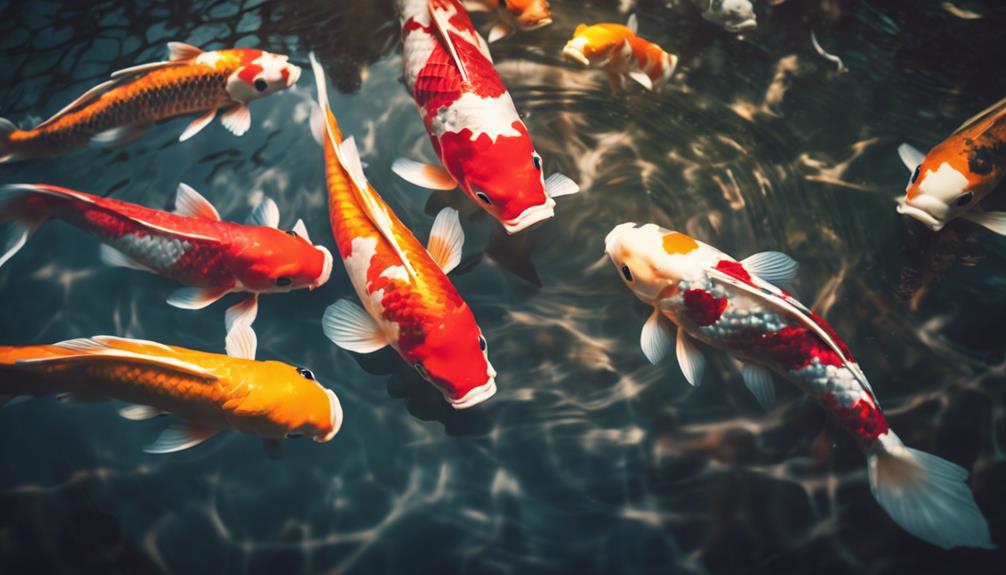When you breed koi varieties, you discover a world of stunning patterns and colors. You'll find iconic designs like Kohaku, Sanke, and Showa, featuring traditional colors like Hi, Shiro, and Sumi. Scale types like Gin Rin and Matsuba add an extra layer of depth, while fin varieties like butterfly and metallic shine koi showcase their unique features. Pattern distribution and classification reveal reticulated, Tancho, and Kuchibeni patterns, each with its own characteristics. As you explore the intricate world of genetic combinations and expressions, you'll discover endless possibilities for new and unique patterns – and that's just the beginning of your koi breeding journey.
Table of Contents
Key Takeaways
- Breeding koi varieties results in over 100 recognized patterns, each with unique characteristics, such as Kohaku, Sanke, and Showa.
- Metallic koi breeds like Hikarimoyo and Hariwake display bright, metallic platinum base colors with varied patterns.
- Gin Rin and Matsuba patterns are scale-dependent, with Gin Rin creating a net-like effect and Matsuba featuring pine-cone-like markings.
- Reticulated patterns achieve a net-like visual effect, often seen in Asagi Koi, while Tancho koi have a single Hi spot on the head.
- Breeding koi varieties can result in unique fin patterns, such as Butterfly Fin Patterns, which greatly impact aesthetic appeal.
Koi Breeding History and Origins
Understanding is vital to grasp that the origins of these vibrant fish can be traced back to ancient China, where they were first domesticated over 2,000 years ago.
The art of breeding koi has since evolved, with Japanese breeders refining the process and developing new koi varieties.
In the 19th century, Japanese breeders began to focus on creating unique scales, colors, and patterns, laying the foundation for modern koi breeding.
Today, koi keeping has become a popular hobby, with enthusiasts worldwide breeding koi to create stunning varieties.
Breeding koi requires a deep understanding of genetics, water quality, and nutrition.
As you plunge into the world of koi breeding, you'll discover the complexity and beauty of these fish.
With over 100 recognized koi varieties, each with its unique characteristics, breeding koi offers endless possibilities for discovery and creativity.
Color Patterns and Combinations
You'll be amazed by the vast array of color patterns and combinations that koi breeders have developed over the years, each with its unique characteristics and beauty.
Traditional colors like Hi (red), Shiro (white), and Sumi (black) are staples in many varieties.
Kohaku, a popular breed, boasts a white body with patches of red markings, while Sanke adds Sumi patterning to the mix.
Showa, on the other hand, has a Sumi base color with red and white markings, and Utsuri pairs black with one other color.
The Goshiki pattern is a standout, featuring five colors: red, white, black, gray, and blue.
If you're drawn to metallic koi, Hikarimoyo and Hariwake breeds are sure to impress.
Hikarimoyo koi display a bright, metallic platinum base color with multiple complementary colors, often muted or diffused due to the strong metallic quality of the skin.
Hariwake, a two-colored metallic koi, presents a platinum base color with an interesting pattern of Hi, Ki, or Beni.
Gin Rin scales can add an extra layer of depth to these already stunning color patterns.
Scale Types and Patterns
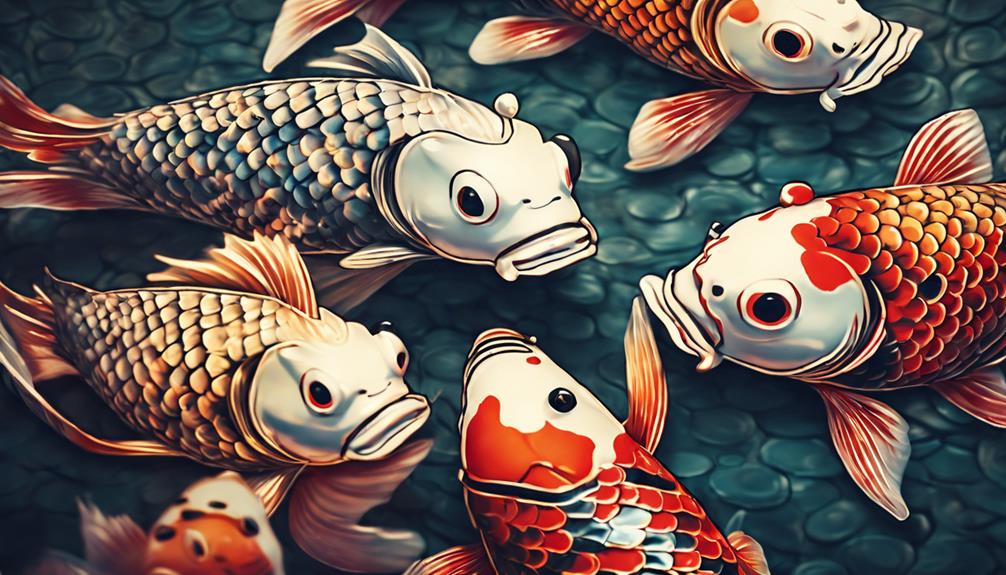
As you explore the world of koi, you'll notice that scale patterns play a significant role in their overall appearance.
You'll encounter various scale patterns, including Gin Rin, which creates a net-like visual effect, and Matsuba, which has its own unique characteristics.
Now, let's take a closer look at these scale patterns and how they're achieved through breeding.
Scale Patterns Explained
When exploring koi varieties, you'll quickly notice that their scale patterns are a key distinguishing feature, with traditional scales, known as Wagoi, being a characteristic of many breeds. However, not all koi have these traditional scales.
Doitsu koi, for instance, are scaleless or nearly scaleless, and they come in three main categories: Leather, Mirror, and Armored patterns.
These unique scale patterns are a result of selective breeding and can greatly impact the aesthetic appeal of your koi.
- Leather patterns: have no more than one row of extremely small scales along each side of the dorsal fin, giving the appearance of a smooth, scaleless body.
- Mirror patterns: have a row of scales along the dorsal and ventral line, creating a reflective, mirror-like appearance on the koi's body.
- Armored patterns: have a random and irregularly sized distribution of scales, giving the koi a unique, armored appearance.
Understanding these scale patterns can help you appreciate the diversity and beauty of koi varieties, and make informed decisions when selecting the perfect addition to your pond.
Gin Rin Characteristics
Gin Rin koi, a popular variety known for their metallic sheen, display unique scale characteristics that set them apart from other breeds, with three primary scale types and patterns that can greatly enhance their visual appeal.
As you examine these koi, you'll notice their scales shimmering with a reflective quality, thanks to the presence of plate-like cells that refract light.
The three primary scale types in Gin Rin koi are: Kingin Rin, which features a bright, mirror-like finish; Dougin Rin, with a more subtle, matte finish; and Gin Rin, which boasts a sparkling, gem-like appearance.
When it comes to patterns, Gin Rin koi often display a hi pattern, characterized by bold, red and white markings that contrast beautifully with their metallic skin.
The combination of these scale types and patterns creates a truly stunning visual effect, making Gin Rin koi a prized addition to any pond or water feature.
Matsuba Pattern Details
Matsuba patterns are characterized by black markings in the center of scales, which create a distinctive pine-cone-like appearance. This unique scale type achieves a net-like visual effect, often seen in Asagi Koi. The Matsuba pattern isn't to be confused with reticulated patterns, which also achieve a net-like effect through the arrangement of scales.
Like other koi patterns, Matsuba patterns can change over time due to ontogenetic color change, which alters the intensity of pigmentation. Matsuba patterns can be combined with other patterns, such as Gin Rin, which features sparkly scales that glitter and glisten. The technical deformity of Gin Rin scales has been bred into many varieties of koi, including those with Matsuba patterns, creating a stunning visual effect.
When examining Matsuba patterns, pay attention to the intricate details of the scales. The black markings in the center of each scale create a beautiful, intricate design that adds depth and complexity to the koi's appearance. By understanding the characteristics of Matsuba patterns, you'll appreciate the unique beauty of these stunning fish.
Fin Varieties and Shine
As you explore the world of fin varieties and shine, you'll notice that butterfly fin patterns are a key aspect of koi breeding.
These patterns can greatly impact the overall aesthetic of your koi, and understanding them is vital for creating stunning variations.
Now, let's examine the intricacies of butterfly fin patterns and how they interact with metallic shine varieties.
Butterfly Fin Patterns
Butterfly Fin Patterns, a distinguishing feature of Hirenaga or Dragon Fin Koi, comprise a variety of fin shapes, sizes, and arrangements that not only add to their aesthetic appeal but also influence their overall health and maintenance requirements.
As you explore the world of Butterfly Koi, you'll notice that their fins continue to grow with the fish, until blood vessels can no longer reach the fin ends. This unique characteristic makes them more disease-resistant, but also requires special care to prevent fin damage.
Some key features of Butterfly Fin Patterns include:
- Long, flowing fins that resemble butterflies or dragons, adding to their majestic appearance
- Pectoral fins that can grow long and fork into elaborate designs, making each fish truly unique
- Fins that require special care, such as keeping them in ponds with smooth surfaces and minimal water movement to prevent damage
As you learn more about Butterfly Fin Patterns, you'll appreciate the precision and care that goes into breeding these stunning fish. Whether you're a seasoned koi enthusiast or just starting out, understanding the intricacies of Butterfly Fin Patterns will enhance your appreciation for these magnificent creatures.
Metallic Shine Varieties
Your exploration of koi varieties now plunges into the dazzling world of Metallic Shine Varieties, where the interplay of fin shapes, sizes, and arrangements converges with an extraordinary luster that originates from the skin itself. As you excavate into this domain, you'll discover the Hikari varieties, classified by their shine, with the word Hikari meaning 'shining' in Japanese. Metallic koi, like Gin Rin, boast a sheen and luster that comes from their skin, not scales. For a koi to be considered truly metallic, the luster should cover its entire body, from nose to tail, and through the fins, shining like polished metal.
| Variety | Description | Key Features |
|---|---|---|
| Hariwake | Two-colored metallic koi with a pattern | Platinum base color, Hi, Ki, or Beni pattern |
| Tancho Hariwake | Variation of Hariwake | Red spot on forehead, platinum base color |
| Gin Rin Hariwake | Variation of Hariwake | Gin Rin scales, platinum base color |
As you explore these varieties, you'll appreciate the unique characteristics that set them apart. The Hi pattern, for instance, adds a striking red hue to the koi's design. With their mesmerizing shine and intricate patterns, Metallic Shine Varieties are sure to captivate any koi enthusiast.
Pattern Distribution and Classification
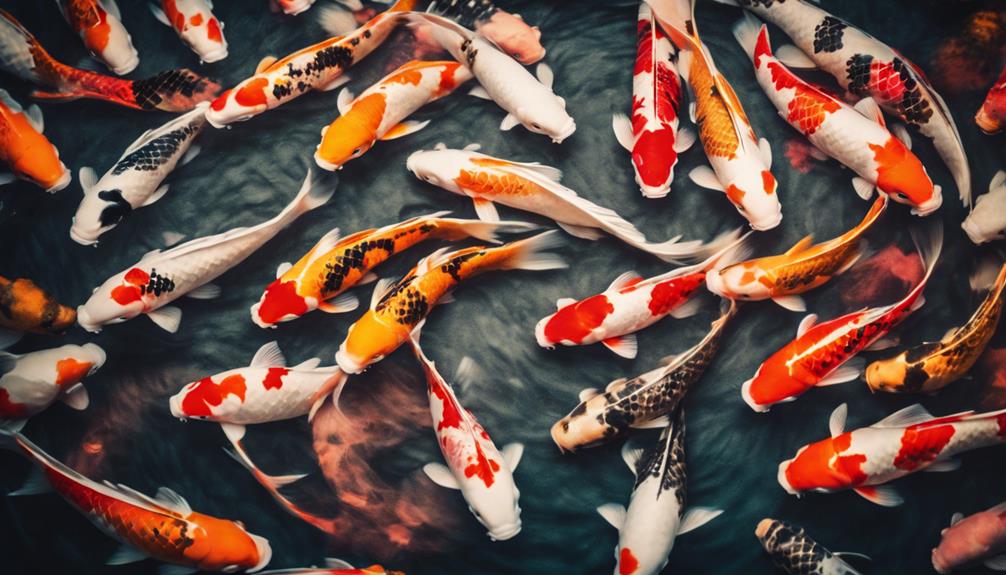
Patterns on koi can be categorized into distinct groups based on their distribution and characteristics, with each type boasting unique features that set it apart from others.
When it comes to pattern distribution and classification, koi enthusiasts can appreciate the intricacies of each type.
Some patterns stand out for their unique characteristics.
Reticulated patterns achieve a net-like visual effect, often seen in Asagi Koi, where the colors blend to create a mesh-like pattern.
Tancho koi have a single Hi spot on the head, named after the tancho crane, and the spot must be between the eyes, not reaching the shoulder or nose.
Kuchibeni pattern occurs when a Hi pattern appears around the lips of a koi with a white head, giving the appearance of wearing lipstick.
Breeding Environment Preparation
To successfully breed koi, prepare a controlled environment that mimics their natural habitat, with specific water quality, temperature, and spatial requirements.
You'll need to create a dedicated breeding tank or pond that's designed to meet the unique needs of your koi.
A vital aspect of your breeding program is maintaining ideal water temperature, which should range from 65°F to 75°F (18°C to 24°C) to promote healthy koi spawn.
Water quality is also paramount, so guarantee you have a reliable filtration system in place to maintain clean and oxygen-rich water.
When setting up your breeding environment, consider the spatial requirements of your koi.
Provide ample space for your fish to swim and thrive, with plenty of hiding places and visual barriers to reduce stress.
Selective breeding requires careful planning and attention to detail, so take the time to research and understand the specific needs of the koi varieties you're working with.
Mating and Spawning Process
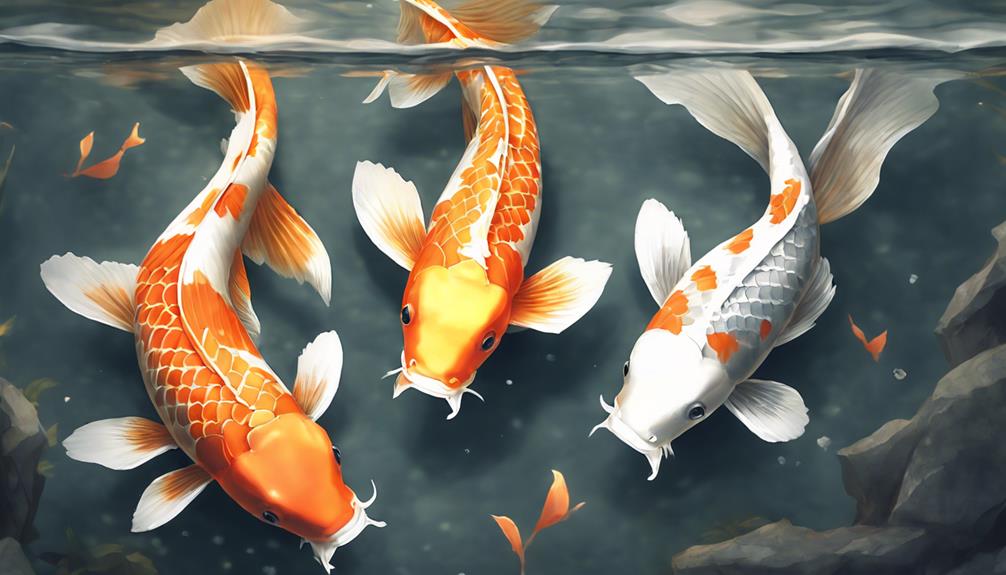
As you prepare to breed your koi, you'll need to create a perfect spawning environment that encourages your fish to mate successfully.
You'll want to guarantee the water quality, temperature, and other conditions are just right to stimulate spawning.
Spawning Environment Preparation
Your koi breeding program's success hinges on creating an ideal spawning environment, which requires meticulous attention to detail in preparing the mating and spawning process.
As a responsible koi keeper, you understand the importance of providing the perfect setup for your fish to thrive. This involves more than just throwing some plants and decorations into a tank.
To guarantee a successful breeding program, you'll need to focus on the following key aspects of spawning environment preparation:
Water Quality
Maintain pristine water conditions by performing regular water changes and monitoring ammonia, nitrite, and nitrate levels.
Temperature Control
Gradually adjust water temperatures to simulate natural spawning conditions, typically between 64°F to 75°F (18°C to 24°C).
Spawning Media
Provide a suitable spawning surface, such as a spawning mop or brush, to encourage egg-laying and reduce egg-eating by the parents.
Spawning Process Overview
You've carefully prepared the spawning environment, and now it's time to induce spawning by simulating the natural mating process, which typically occurs at dawn or early morning when water temperatures are rising. This is a vital step in breeding koi varieties, as it allows you to control the spawning process and increase the chances of successful fertilization.
To initiate spawning, you'll need to introduce the selected individual koi for breeding into the prepared environment. Males will begin to chase females, and eventually, the females will release their eggs. During this process, the males will fertilize the eggs, resulting in the formation of zygotes.
It's vital to monitor the spawning process closely, as you'll need to remove the adult koi from the environment to prevent them from eating the eggs or newly hatched fry.
A successful spawning process is pivotal for producing high-quality koi varieties. By simulating the natural mating process and controlling the environment, you can increase the chances of successful fertilization and improve the overall health and quality of the resulting fry.
With careful attention to detail and a well-planned breeding strategy, you can reveal the full potential of your koi for breeding and create stunning patterns in your koi varieties.
Koi Selection and Care Essentials
Selecting the right koi for breeding and providing them with ideal care is crucial for producing healthy offspring and successful breeding programs. As a breeder, you want to guarantee that your koi are healthy and thriving, as this will directly impact the quality of their offspring.
When selecting koi, remember to:
- Choose koi that are at least 3 years old, as they're sexually mature and can produce healthy offspring.
- Select a minimum of 1 male and 1 female koi for breeding, guaranteeing they've desirable characteristics.
- Look for koi with healthy scales, as they'll pass on this trait to their offspring.
In addition to selecting the right koi, providing them with proper care is essential. Feed your koi four times a day, with a focus on protein-rich foods, to support their bodies during breeding.
Avoid breeding koi with injuries, as they may sustain further damage during breeding.
Environmental Factors and Influence
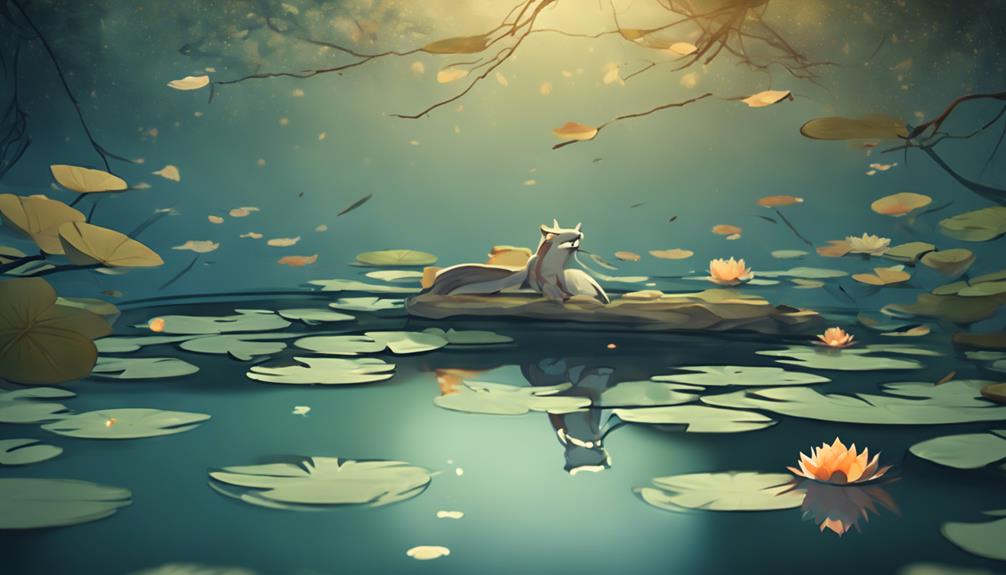
Environmental factors, such as water quality and temperature, exert a profound influence on the breeding process, and careful control of these elements is crucial for successful koi reproduction.
You'll want to guarantee that your koi are living in a stress-free environment, as stress can affect the development of their colors and patterns. For example, Kuro Goshiki koi, known for their black and white scales, may develop uneven sumi (black) patches if they're exposed to fluctuating water temperatures.
When breeding koi, you'll need to maintain prime water quality by monitoring pH levels, ammonia, and nitrite levels. You should also provide plenty of hiding places and visual barriers to reduce stress.
Additionally, maintaining a consistent water temperature between 65°F to 75°F will help promote healthy development of colors and patterns. By controlling these environmental factors, you'll be able to breed koi with vibrant, well-defined colors and patterns.
Genetic Combinations and Expressions
When exploring the intricate world of koi breeding, genetic combinations and expressions play a crucial role in producing the stunning colors and patterns that make each variety unique.
As you plunge into the world of koi breeding, you'll discover that the possibilities are endless, and it's the genetic combinations that bring these incredible patterns to life.
Some of the most striking patterns and colors are achieved through specific genetic combinations.
- The Asagi variety's reticulated pattern creates a net-like visual effect, often seen with other colors and patterns.
- The Gin Rin pattern, a technical deformity, gives a sparkly, glittering effect to the scales.
Selective breeding has expanded koi colors and patterns to include blues, oranges, yellows, silvers, and more, with Hi (red), Shiro (white), and Sumi (black) making up the core canvas of many varieties.
Frequently Asked Questions
What Does the Koi Fish Pattern Mean?
As you gaze at a koi's pattern, you're witnessing a symbol of perseverance, good fortune, and spiritual growth. In fish mythology, koi patterns hold cultural significance, representing strength, courage, and wisdom, reflecting your own journey towards self-discovery and enlightenment.
What Is the Rarest Koi Fish Pattern?
As you excavate into the world of koi, you'll discover that the rarest traits, desired mutations, and pattern anomalies are shrouded in genetic mysteries, with the elusive Goshiki pattern, boasting five colors, reigning supreme as the holy grail of koi breeding.
How Does Koi Breeding Work?
You're about to plunge into the world of koi breeding! It involves mastering breeding techniques, understanding genetic factors, and making strategic spawn selections. Effective broodstock management is key to producing high-quality koi with unique patterns and characteristics.
What Type of Inheritance Influences the Coloration of Koi?
You'll discover that koi coloration is influenced by polygenic traits, where multiple genes interact, and epistatic interactions, where one gene affects another. Genetic dominance and Mendelian principles also play a role, shaping the unique colors and patterns you see in these fish.
Conclusion
As you plunge into the world of koi breeding, you'll uncover a kaleidoscope of patterns, a symphony of scales, and a dance of fins.
The possibilities are endless, like a painter's palette waiting to be mixed and matched.
With each new generation, the genetic puzzle pieces come together in unpredictable ways, creating unique masterpieces that will leave you mesmerized.
The art of koi breeding is a never-ending journey of discovery, where the boundaries of beauty are constantly pushed and redefined.

